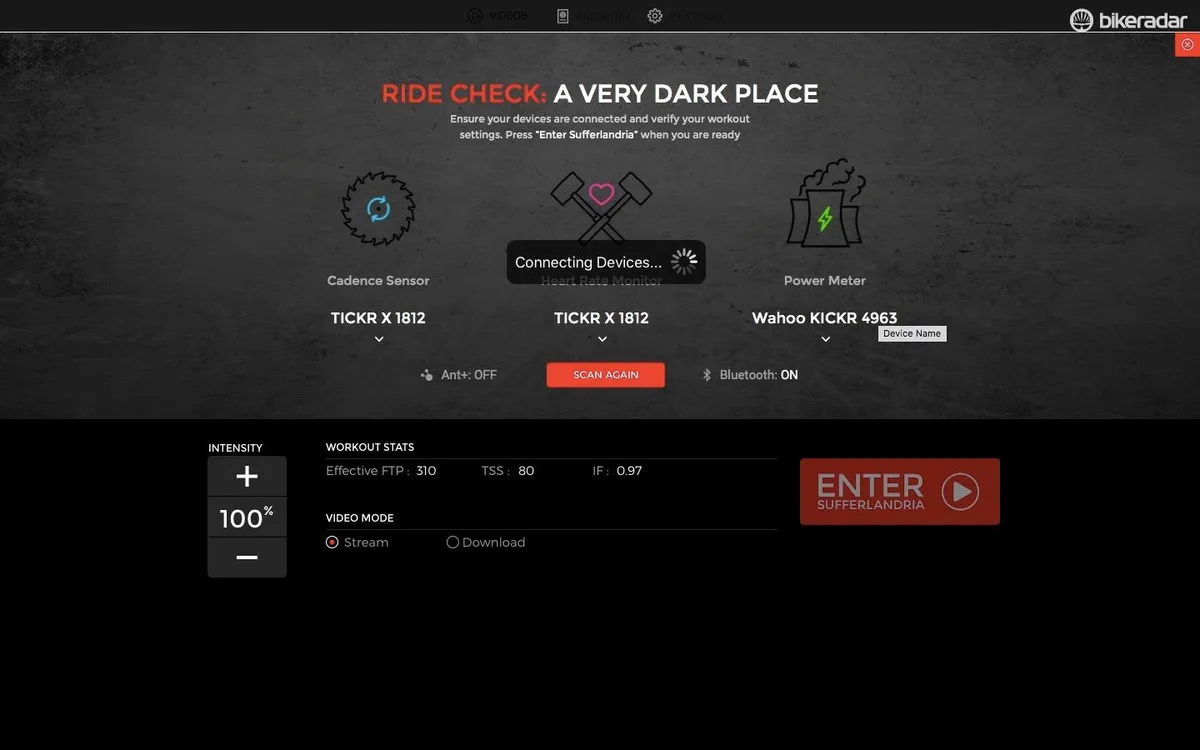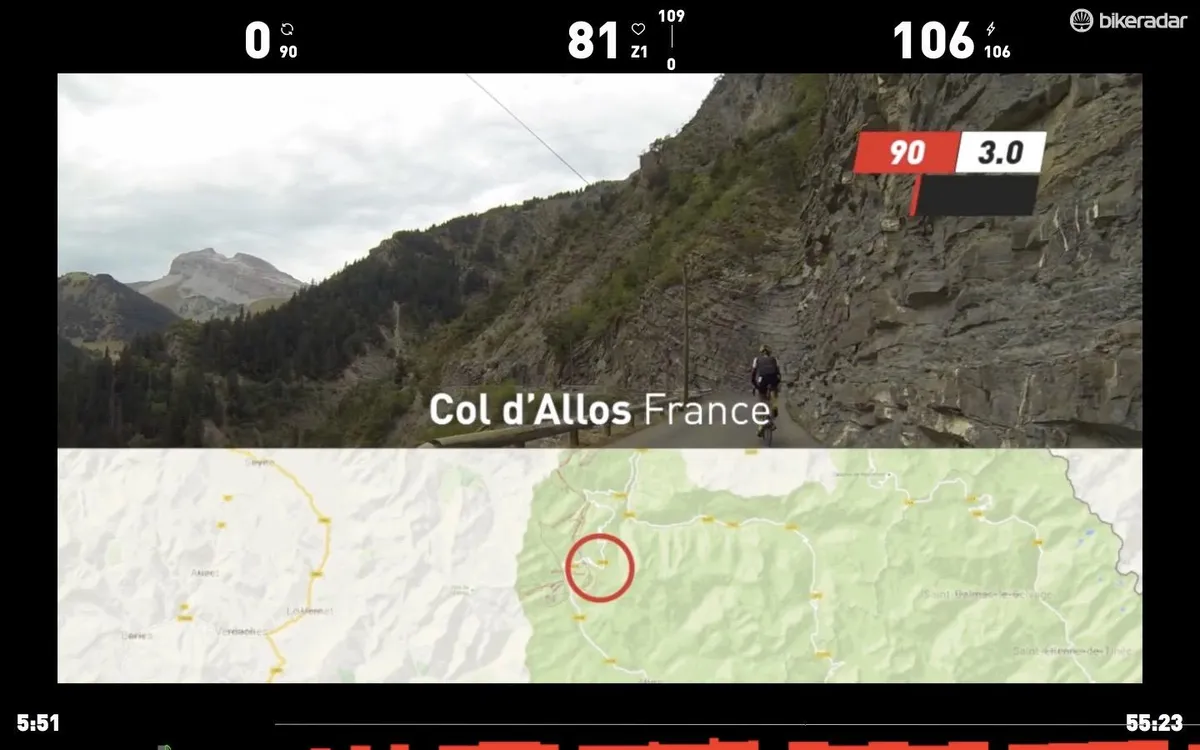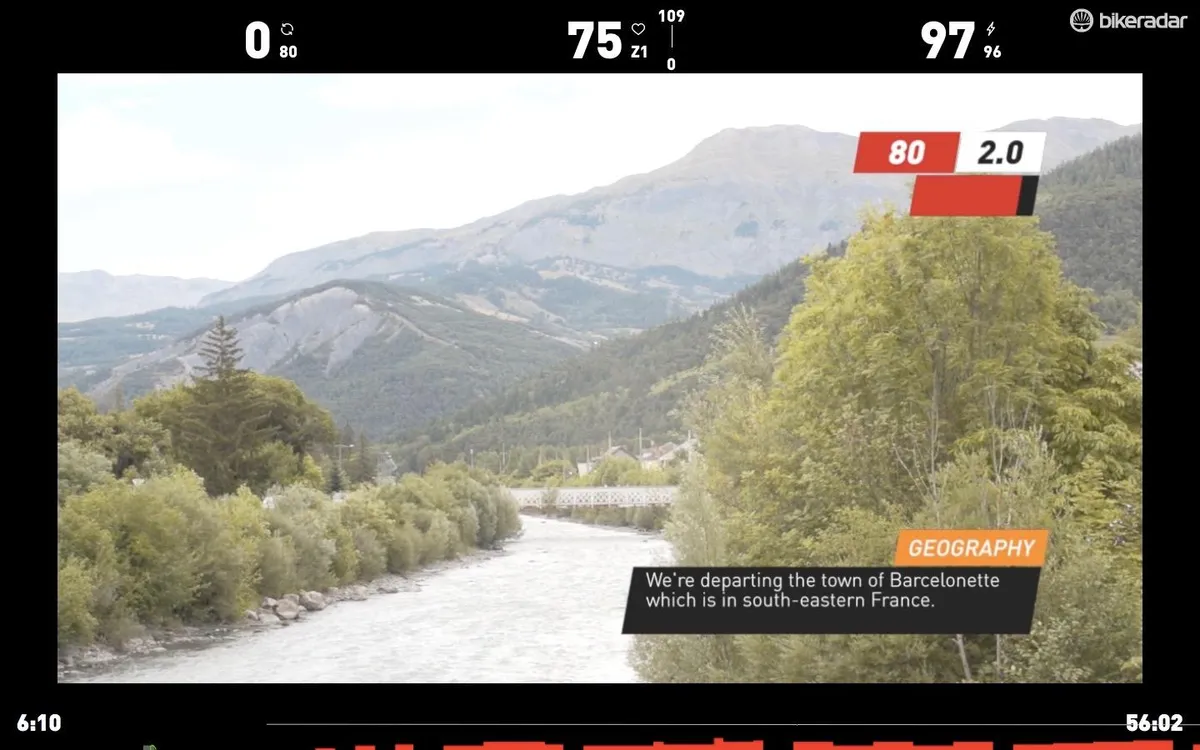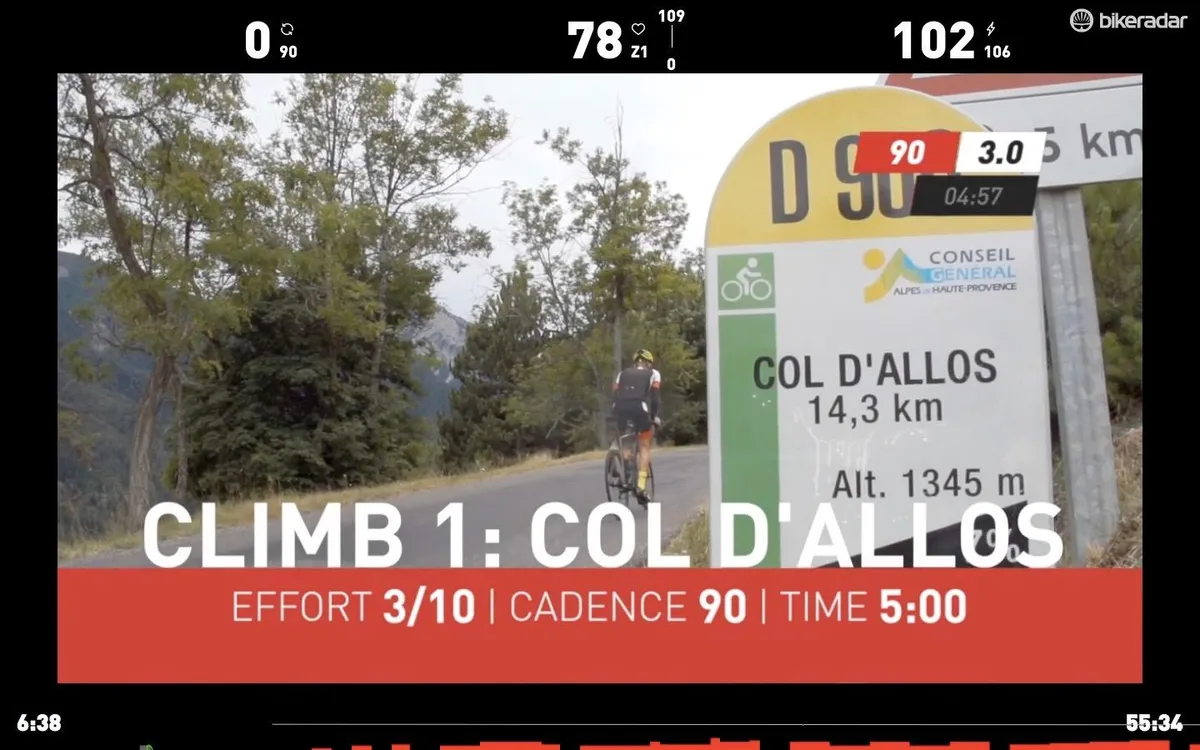After several years of producing interval videos overlaid onto official race footage, The Sufferfest has an app that integrates with heart-rate monitors, power meters, cadence sensors and smart trainers for interactive trainer workouts. It works on iPhone, Mac and PC, and an Android app is in beta.
The licensed race footage from events such as the Tour de France, the Giro d'Italia and Paris-Roubaix syncs nicely with the prescribed intervals. Apex Coaching founder Neal Henderson (who works with pros like Rohan Dennis) translated The Sufferfest's interval scale for perceived effort to a specific power target, based on your FTP (functional threshold power).
The videos are well done and have been popular in trainer classes. Having power targets makes the workouts much more specific than rate of perceived exertion (RPE), and, of course, having power allows you to not only quantify the workload but also measure improvement.

There are 47 workout videos, searchable by type and duration. The preview function for each is good, showing the workout in bar-graph form, giving a text overview and bulletpoint synopsis, but also offering a video preview of the workout.
Each workout has intervals with specific targets for heart rate, power and cadence. When tools for each are paired via Bluetooth or ANT+, you get color-coded feedback as to whether you are at, above or below the targets.
If you are using a smart trainer such as a Kickr, then the app controls the resistance. If you don't have a power meter (or a smart trainer), the app has a virtual power function that lets you train with watts based on a trainer-specific algorithm that incorporates speed and cadence.
One small (but key) feature is the ability to adjust workout intensity on the fly. This is especially useful when riding a smart trainer. If the workout is just a touch too hard or too easy, a quick tap on the down or up arrow will fix that. (When used on a Mac, this also turns down the music volume, though, so you have to turn the volume back up separately.)

Another nice feature is the ability to jump ahead or back in workouts. Feel like you have one more interval in you? Then pause, and scroll back to do it again. Feeling smoked or short on time? Then scroll ahead. The app won't judge.
The new interactive interface is quite similar to the popular TrainerRoad software and app, which perhaps isn't too surprising considering TrainerRoad co-founder Reid Weber now works for The Sufferfest. TrainerRoad, however, has more than 1,000 workouts plus a workout builder if you want to create your own.

The company's history with workout videos is a double-edged sword. On one hand, the library of officially licensed race footage is fairly unique and most of the details from the RPE-based videos transfer over sensibility to the app, such as text reminders to relax your shoulders. On the other hand, having a host of RPE numbers and time counters embedded in the video is redundant if not confusing when viewed in the context of the specific power and heart-rate targets.
Unlike the Zwift interactive video game, The Sufferfest is a solitary experience. The race footage is cool, but it can get a little repetitive after a few sessions.

4DP — FTP 2.0
When The Sufferfest launched its 4DP training system, there was a fair bit of controversy for an update to a training app.
This new platform is based around a fitness test called Full Frontal, which was developed by Henderson over years of working with top-level athletes across many disciplines. So instead of the standard 20min FTP test where you basically do a time trial and then average the power for that duration, Full Frontal is broken into four different efforts — neuromuscular, anaerobic capacity, maximal aerobic power, and FTP. The Sufferfest claims this better isolates your FTP and also gauges your physiological systems above threshold.
“As soon as you go north of FTP, the variation in the population is just massive,” said Mac Cassin of Apex Coaching, who played a role in developing 4DP. ”There are guys who are really good at sprints who can put down big watts but struggle with long efforts, and then you get other guys who can do eight minutes way harder than they should be able to based on their FTP, but can't sprint."
What Full Frontal does is define these above-FTP thresholds (supra-threshold) to identify your rider type and then takes this information and applies it to each of the workouts inside the app.
Sufferfest claims this better tailors the intervals to what you’re capable of doing rather than basing them on a percentage of your FTP as the majority of the other training apps do. And this is where the controversy with the 4DP platform lies.

Henderson, Cassons, Apex Coaching and The Sufferfest did not invent supra-threshold, a fatigue resistance profile or the idea that two riders with the same FTP will perform differently once you go above that threshold, nor do they claim to.
If you’re willing to do a bit of reading, there are plenty of books where you can learn to calculate these values on your own, and there are other apps such as WK04 and Golden Cheetah that will calculate these values but won't tell you what to do with them. These apps are also not particularly user-friendly and are targeted at coaches, not riders like you and I.
It’s here where The Sufferfest has done something quite exciting for the everyday rider who’s looking to get faster. Not only does 4DP help you define these various thresholds based on your physiology, but then the app automatically applies them to the all the workouts in The Sufferfest’s catalogue — all you have to do is complete the Full Frontal Video. Xert has a similar feature set in its app.

The one-hour Full Frontal test itself is not easy. It consists of a couple of 5-second efforts, one 5-minute effort, the standard 20-minute effort and finally a particularly miserable 1-minute effort.
Once you’ve finished the test, the app tells you your rider type and recommends workouts that will help improve your weakness as well as those that play to your strengths.
When I first did the 4DP test I was coming off the couch having just beaten a particularly nasty bout of flu, which took me off the bike for a few weeks. I was ‘well rested’ for my test. The app identified me as a Pursuiter, which was no surprise, though my FTP was a bit lower than I’d expected.
But wait there's more…
Also contained in The Sufferfest app, are full training and nutrition plans, yoga and mental training too.
Designed by Apex Coaching the training plans are detailed and included in the $10 monthly fee, however they come in the form of downloadable PDFs, which seems behind the times. We’d really like to see the plans integrated into the app. That said, The Sufferfest has also made 35 training plans available on Trainingpeaks, which are available for free if you've got a subscription to the app.

My favorite feature of The Sufferfest app is the yoga. Yoga has helped me bounce back from injuries and improved my flexibility and core strength, things that are often neglected by cyclists.
The Mental Training video series is designed to change the way to approach challenges and how you see yourself and achieve goals.
I struggled with this aspect a bit as it’s less tangible than a trainer workout. There isn’t that instant gratification or the endorphin rush like when you finish a trainer session and the progress is a bit harder to track.
Having said that I do think the mental training is extremely valuable, especially when it comes to the module on positive self-talk.
The verdict
When it comes to training apps, the big three have slotted themselves into a unique niche, each offering something the others don't. Zwift has its train-with-a-party-hat-on group riding and racing. TrainerRoad has its gargantuan catalogue of workouts and training plans.
The Sufferfest has its basis in workouts overlaid with race footage and its signature sense of humour. The new 4DP training system is making tailored workouts that before required a coach or slogging through dense reading available to the masses.
There is also value in the extras you get with the app, with the training plans, yoga, and mental training. The Sufferfest has said they have plans to add strength training to the app, which will make it a one-stop shop when it comes to training.
The big question is where does it rank when you compare it to other training apps. The Sufferfest noses ahead with the 4DP tailored workouts and the extras, but being that you’re training on your own, the videos can get a bit old after you've done them 20 times. It’s in this respect where the other two make up ground. The Sufferfest also doesn’t have an Android app yet.
But here’s the thing — you’re going to get faster with any of the three, the important thing is to find the app that you enjoy using. If you like to watch old races and are looking for an app that offers more than just cycling workouts than The Sufferfest is probably going to suit you well.
A subscription to the app will set you back US$10 per month, which following the Zwift's price rise, makes it the cheapest of the three big apps. You can try The Sufferfest Training Center app for free for a 7-day trial.







